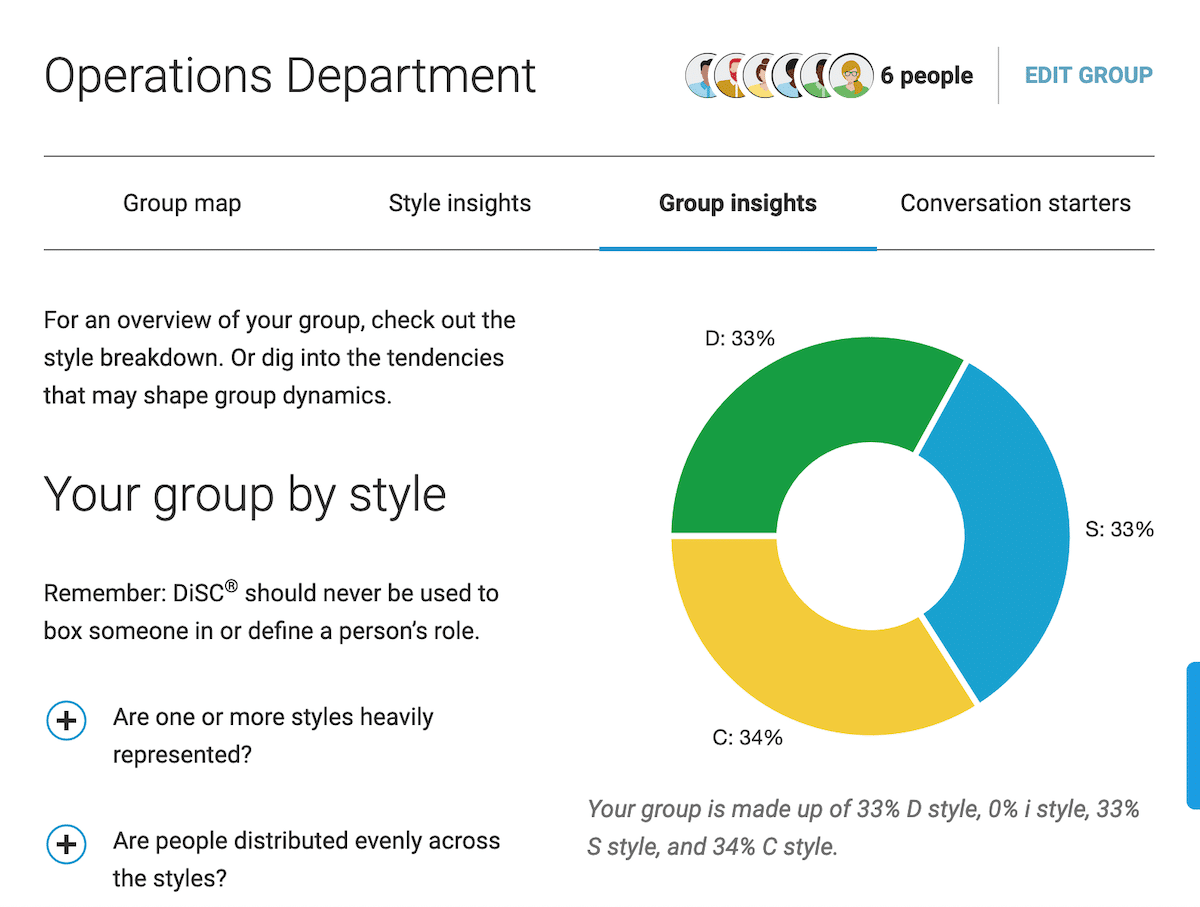DiSC and AI? How are they connected?
Everything DiSC® assessments are great at helping people identify both natural strengths and the skills and tasks that require more time and energy. DiSC insights can help us decide when it’s best to bring in additional resources to help. These resources can include vendors that specialize in tasks that are more difficult for you, members of your team with complementary strengths, or helpful workplace technology tools.
One popular variety of workplace technology that’s dominating both the news and professional development plans across the globe is artificial intelligence (AI). Artificial intelligence refers to computer-based systems that are capable of performing tasks that historically only a human could do, such as reasoning, making decisions, or solving problems.
While AI has been around for many years, it exploded into mainstream culture in 2022 with the release of ChatGPT.
Forbes explains,
“OpenAI released an early demo of ChatGPT on November 30, 2022, and the chatbot quickly went viral on social media as users shared examples of what it could do. Stories and samples included everything from travel planning to writing fables to code computer programs. Within five days, the chatbot had attracted over one million users.”
AI tools can bolster efficiency, supplement when a team is lacking a particular skill, and facilitate skill development.
ChatGPT is capable of helping with more creative, inherently human tasks, including writing and content creation. It naturally piques human curiosity. Its launch brought on both excitement and fear around how technology might impact the workforce.
In recent years, numerous new forms of workplace AI technology have emerged, normalizing the use of AI in daily professional lives. Their functions range from basic tasks like scheduling to more advanced tasks like forecasting and decision-making.
These tools have the potential to bolster efficiency, supplement when a team is lacking a particular skill, and facilitate skill development.
At Discprofile.com, we’ve been thinking about the potential positive impact of combining insights from DiSC with the power of AI. Imagine this: You take an assessment like Everything DiSC Workplace® and discover your own natural strengths and preferences. This gives you an idea of where you’ll require some extra support, and what you’ll want to work on to grow and expand your skills!
Then you log onto the Catalyst™ learning platform and notice that you have some teammates with complementary strengths, but in general, your team has a couple of common stressors. When it comes to tasks related to those stressors, you could use some additional training and support.
If your team is interested in AI adoption, imagine how interesting it could be to take these insights, and find an AI tool that supports you with some of those more difficult tasks. Not only would your team gain some experience with AI tools, but they’d also get the chance to practice tasks that used to stress them out in a new way. It allows the team to learn something together.
By combining the power of human connection and exploration with sophisticated technology, you have the ability to elevate your entire organization!
The conversation around workplace AI
Questions about what AI technologies can do and how they might affect our lives at work have become core to the conversation around workplace productivity. New headlines emerge every day about AI tools and the way they could change the nature of how we do work.
Wiley Workplace Intelligence surveyed 3,000 people across different industries to learn what people are thinking and feeling about AI in the workplace. They found some key insights around which industries are currently using AI, and which ones have a lot of room for discovery. Service operations, marketing and sales, and product development have the highest AI adoption rates, while HR and risk have the lowest adoption rates. However, the stats showed that AI is actively being adopted across a wide array of industries—there are potential applications across the board!
They also found that the biggest barrier that’s preventing AI adoption is budget, with 25% of respondents noting that budget constraints were a significant barrier to AI integration.
64% of those surveyed agreed that using AI for administrative tasks will increase efficiency.
Experience is everything
While AI isn’t capable of performing all jobs and adding the human touch that’s necessary in most job functions, it is becoming widely adopted across multiple industries as a tool to strengthen existing operations. Wiley’s Workplace Intelligence survey found that almost one-third of those surveyed said their business has adopted AI technology in at least one business function.
Experts have explored numerous potential applications and benefits, including:
- Increasing efficiency and productivity by automating more repetitive, mundane tasks
- Advanced and predictive data analytics capabilities that come with AI’s ability to manage huge quantities of data
- More personalized customer experiences
However, the World Economic Forum reports that fully leveraging these benefits will require experience and expertise:
“To unleash the potential of AI safely, however, issues such as accuracy, human control, transparency, bias and privacy need to be addressed. So, governments and businesses should be role-modeling the ethical use of AI, and educating their people on AI and how to be ready for the opportunities and challenges.”
Teams must begin to learn about AI and practice using it ethically in order to reap its benefits. They need to learn about the technology itself, the bias and ethics concerns around it, and how it can be leveraged safely to bolster their operations. So, how can businesses and individuals begin to do this?
The experts at Levity AI explain that companies can start taking advantage of AI technology by incorporating it into their day-to-day operations on a smaller scale. With use cases across multiple business functions, workplace AI can help with decision-making and improving business outcomes while giving people valuable experience working with this cutting-edge tech and prepping organizations for the future.

What outcome do you want to produce?
When you decide to integrate an AI tool into your day-to-day operations, it’s also important to consider where the AI tool will fit best.
Primarily, you should think about what outcome you want to produce. What are your team’s natural strengths?
Consider zooming into the “Your Groups” and “Group Continua” sections of Everything DiSC on Catalyst to see what strengths are prominent on your team, and what strengths don’t come as naturally. Ask yourself:
- What are some areas that are lacking?
- What stresses your team members out?
- What energizes them?
- What needs aren’t being met as a result of these strengths and gaps?
As your team ponders these questions, consider how the addition of a new AI tool might be able to help.

What role do you want AI to play?
Want to try using AI technology on a small scale? Interested in getting experience with AI by adopting an AI tool on an individual or small-scale level? In addition to selecting the outcome you want to produce, you’ll also want to identify the role AI can play in reaching that outcome.
BCG‘s AI researchers explain that effectively getting started with workplace AI technology involves identifying a problem you want to solve, discovering the type of AI that’s best suited for that problem, and adapting as the problem evolves due to changing context and scenarios.
Here are the different types of AI tools they identify:
- Automator: Some kinds of AI, like marketing automation tools, have all the context they need to reach decisions. In this case, the AI can automatically carry out tasks.
- Decider: Sometimes, AI has plenty of context but requires a human to double-check its results and carry out implementation. An example of this is call center optimization technology that helps people determine what to say and how to say it.
- Recommender: AI plays a recommender role when multiple, repetitive decisions need to be made but human decision-making is required to round them out and finalize them with necessary context. An example of this is sales or operations planning AI.
- Illuminator: In this case, AI can gather insights that will help people with inherently creative work. One example of this might be using an AI tool to examine customer complaints and find common themes. This could help a team to craft better customer service processes.
- Evaluator: Sometimes, AI tools can’t gather enough information or context on their own, so humans need to come up with scenarios for the tools to evaluate.
As you can see, AI can play a number of different roles depending on the task at hand and the technology’s ability to gather and process information. Understanding the outcome you want to produce and the role you want AI to play will help you select a tool that’s truly effective.

Where do I start?
Teams are using these thought processes to identify day-to-day tasks where AI could add value. 64% of respondents in Wiley’s Workplace Intelligence survey reported that they believe using AI for administrative tasks will increase efficiency.
Teams can also look at the skills they’re lacking and attempt to find an AI tool that facilitates growth in that skill.
For example, if your team has a lot of members with big ideas but lacks more detail-oriented individuals who keep projects organized, you could consider adopting a project management and scheduling tool to help incorporate project organization into everyone’s day-to-day routines.
If your team is full of analysts who love to dig into numbers and data, but lacks individuals who thrive by getting creative and thinking outside of the box, you could incorporate a tool like Chat GPT that helps with the creative ideation process.
You can also start using it on an individual level by examining your DiSC results and seeing where AI might be able to offer some support.
An example from the author
As an i-style marketing professional, I tend to get very enthusiastic about ideas and creative components. I’m fast-paced and I like to work on multiple projects at once. Sometimes I need a bit of extra support with the more precise, detail-oriented tasks. So, in my day-to-day work life, I like to incorporate AI tools that help with those areas. I use proofreading software to ensure I don’t miss any mistakes when proofreading. I use automated social media post schedulers to ensure I don’t forget to post on company accounts on the planned days and times. I use AI transcription tools to write out interviews and highlight important words and themes in them.
Any DiSC assessment taker can use this same kind of self-knowledge to select some AI tools and start practicing with them!
Style-based recommendations
We’ve compiled some recommendations for starter AI tools based on the typical characteristics of each style. But remember – every individual is different! It’s important to look at your own results and gain insights into where AI might be helpful based on that.
D style
Data analysis tools
D-style individuals tend to be passionate about achieving excellent bottom-line results and can get stressed when they don’t have a pulse on performance. An AI-powered data analysis tool could be useful for D-style team members who always like to have one eye on the bottom line. AI-powered tools can automate the creation of dashboards and reports so that insights are delivered to you and your stakeholders in real time.
Transcription/note-taking
Since D-style individuals tend to be fast-paced and like to move on to the next task, it can be difficult to do more tedious, detail-oriented tasks, such as transcribing meetings or interviews, or taking detailed notes. In this case, a transcription or note-taking AI that automatically records and writes down the contents of key meetings and events could come in handy. One example is Otter AI.
Organization and inbox management
The mundane task of organizing an email inbox might make a fast-paced, action-oriented D style groan with frustration. However, AI-powered inbox management tools can help with this! Tools like Levity can help prioritize important emails, sort them into categories, and automate responses.
i style
Proofreading
Fast-paced, enthusiastic i styles can lose track of the details if they aren’t careful. When it comes to writing-centered tasks, AI proofreading and suggesting tools can help i styles ensure their communications are grammatically correct and communicating effectively amid all their natural excitement!
Scheduling
i styles tend to take on any opportunities they get to build connections and relationships. Because of this, their calendars can get unruly. Scheduling tools like Clockwise can help them keep their calendars organized, and ensure they have time for focused work on key projects.
S style
Prioritization
S styles often place a high value on providing support, causing their task lists to fill up quickly! It’s important for them to prioritize and communicate with their teams about the priority levels of different tasks. AI-powered project management systems like Asana and ClickUp can help with this.
Chatbots
S styles generally prefer to have time to ponder and deliver the best possible solution to a problem or question. To help with fast-paced questions from clients, customers, and coworkers, S styles could consider using a chatbot or decision tree software. This can help them develop a process for formulating solutions when they’re pressed for time.
C style
Conversation starters & social hours
C styles are generally masters of directness and accuracy. But coming up with ideas for the social side of work can take a bit more energy. C-style individuals can use AI tools like ChatGPT to come up with ideas for beginning-of-meeting conversation starters and group events. They can even make specifications for these tools about the kinds of topics they’re interested in and the kinds of activities the team will enjoy.
Creative tasks
Sometimes, C-style colleagues might need some extra energy to come up with new ideas for creative projects that are outside of the frameworks they know. They often prefer what’s tried and true, and they don’t want to create something that doesn’t work or is poorly received. Fortunately, AI can be a superpower when it comes to creative ideation. Fast Company article explains how text generator AI can be helpful in the ideation process:
“A way to generate good ideas is to change the boundaries of the problem by altering the constraints you face. This allows you to see a problem in a new way, which might lead to new solutions.”
When you look at your DiSC style in depth, you’re able to get a good view of what comes naturally to you at work and what stresses you out. This is a great way to select an AI tool and start getting experience on a smaller, more affordable scale.

Continuing soft skill development
It’s important to remember that while AI is powerful, we also need to continue to hone the inherently human skills that AI can’t replicate. Emotional intelligence, strategy creation, ethical thinking, and cooperative skills are all necessary for people who wish to effectively use AI technology. And they all need to be developed by you!
One article from the HBR notes, “In most knowledge-intensive tasks, workers will more likely find themselves augmented in partnership with machines than automated out of a job.”
Soft skills are key to the AI integration formula.
These tools can augment workplace performance, but the ability to use these tools effectively and ethically hinges on individuals’ abilities to check after them. As teams develop their ability to leverage AI, they should also continue to develop their soft skills, as they are key to the AI integration formula.
Emotional Intelligence development tools like Everything DiSC Agile EQ®, team building tools like The Five Behaviors® Team Development, and leadership profiles like Work of Leaders® can all add value to this continued development.

